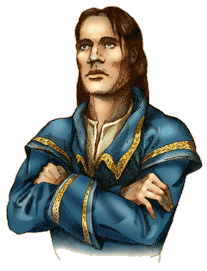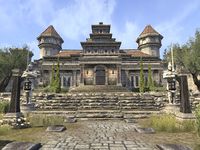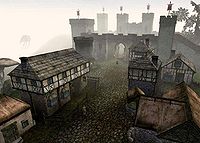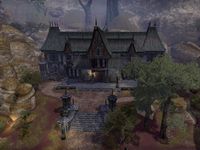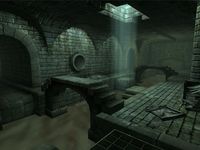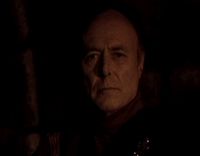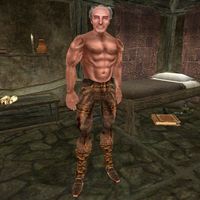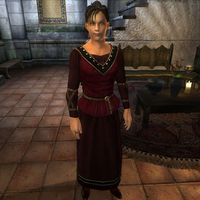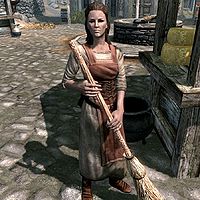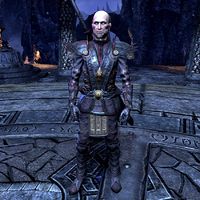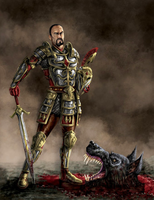User:Imperialbattlespire/Imperials
Also known as Cyrodiils, Cyrodilics[1], Cyro-Nordics and Imperial Cyrods[2], the well-educated and well-spoken Imperials are the natives of the civilized, cosmopolitan province of Cyrodiil. Imperials are also known for the discipline and training of their citizen armies, and their respect for the rule of law.[3] Though physically less imposing than the other races, the Imperials have proved to be shrewd diplomats and traders, and these traits, along with their remarkable skill and training as light infantry, have enabled them to subdue all the other nations and races and erect the monument to peace and prosperity that comprises the Glorious Empire.[4][5] Their hegemony has waxed and waned throughout the eras, and most historians refer to three distinct Empires, the ends of which each mark a new epoch in Tamrielic history.
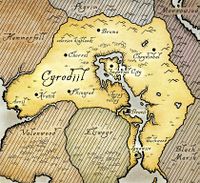
Contents
History[edit]
The Imperial race emerged out of the original Nibenese tribesman, Nedes and Cyro-Nords in the Merethic Era.[1][6][7] They were subjugated by a race of Aldmer, the Ayleids, but a rebellion against these rulers, formed under the guidance of Saint Alessia in 1E 242, would prove so successful that Ayleids were driven to extinction (though they left behind many treasures[8]).[1][6][9] The Alessian Empire united Imperials and pursued campaigns in other provinces, but when the Colovian west broke away, the resulting civil war in Cyrodiil ended the Empire.[6]
The eastern Nibenay Valley region and the western Colovian Estates developed distinct cultures, but still united under the Colovian Reman I to repel an Akaviri invasion in 1E 2703, creating the Second Empire.[1][6] The Akaviri had devastated many human lands, and Reman feared invasion from the Summerset Isle, so he allowed the remaining Akaviri to live and fight for him against the Elves.[6] Soon the Second Empire controlled every province of Tamriel except Morrowind.[6] The events surrounding the attempted conquest of Morrowind led to the end of the Reman emperors, and the First Era, in 1E 2920: the Akaviri Versidue-Shaie, who had earned a position as a trusted advisor, took control following the deaths of the Remans and the disastrous Four-Score War.[10]
The Akaviri Potentates would rule until 2E 430, but eventually assassinations and poor leadership would make the Empire crumble, leading to the Interregnum: for four hundred years, petty states all over Tamriel quarreled with each other, especially Cyrodiil.[1][11] The Imperial Province devolved into a collection of warlords squabbling over a no-man's land of cultural stagnation.[1][12] Eventually, it would take a Nord to reunite the Imperial Province: Tiber Septim was appointed general of the forces of Cuhlecain, a petty Colovian king. He routed all of Cuhlecain's enemies who would face him and his armies on the battlefield, quickly reuniting Cyrodiil. When Cuhlecain was assassinated in 2E 854, Tiber Septim assumed the throne.[6] In a few decades, the provinces would be reunited once more under his Third Empire, and this once-outsider to Cyrodiil had become the symbol of the whole realm.[1]
Ironically enough, most if not all of the Emperors of the Third Age would be Nordic or Breton, not Imperial. Following the cataclysms of the Oblivion Crisis, the leaderless Empire would once again begin to crumble, but it was an Imperial who seized the opportunity for glory: Titus Mede, a Colovian king, would seize the Imperial City with less than a thousand men and declared himself the new Emperor, though not much is yet known about this new dynasty.[13]
General Culture[edit]
Imperial culture is known for being pragmatic and not only bringing together the various cultures of the Imperial provinces, but also backed behind by a strong hereditary, emperor and bureaucracy, which unifies their culture. The rule of law, a powerful professional army, and tolerance of disparate polytheistic cult worships play a major role in Imperial Culture. Education and wealth is distributed through all social classes where Imperial culture has flourished, many citizens are thus literate and protected under Imperial law.[14]
The defining feature of Imperial culture is its cosmopolitanism.[1] Although some individuals may be the most arrogant bigots in Tamriel,[15][16][17] culturally the Imperials are very conciliatory and congenial, making them skilled diplomats and traders.[1] Even Imperial Vampires claim some semblance of civility.[18] It's easy to understand given their geography and cultural schisms: Cyrodiil borders almost every other province, and the historical separation yet underlying unity and interaction of the Cyrodilic regions made the Imperials well practiced at building bridges and maintaining order. Though there are many regions, the two most powerful effectively controlled all regions close to them: the western Colovian Estates and the eastern Nibenay Valley.
"Law and custom despises dishonorable duelists. If the victim was bullied, intimidated, or goaded by a stronger party with suspect motives, magistrates often convict the stronger party of foul murder." "Native Dunmer and Imperials alike recognize a noble's obligation to answer a challenge of honor." "A challenge of honor is a public declaration of a scandal against a private party. Only nobles fight duels, and the higher the rank, the stronger the obligation."
The Imperials have many Akaviri influences.
The martial ability of the Akaviri soldiers had a strong influence on the military hierarchies of Tamriel. The Imperial Legion benefited from the superior organization and tactical knowledge of the Akaviri, and the political and legal systems of the Empire were both improved as well.[19] The Akaviri Potentate's peculiar armorsmithing practices was said to have changed the Imperial legions forever.[20] It was an Akaviri, Dinieras-Ves, who first proposed what would become the Fighters Guild to his kinsman, the Potentate Versidue-Shaie.[21] The Empire in general benefited from the influence of Akavir.[19]
Akaviri surnames are rare and prized possessions among the Cyrodilic citizenry of today, and their genes can be seen within distinguished Cyrodilic families.[22]
- https://en.uesp.net/wiki/Online:Homesteads_in_the_Black_Marsh - Homesteaders lore
Food[edit]
- Main Article: Imperial Cuisine
Imperial cooks approach food the same way they face the rest of life: in a straightforward and proud manner. As shrewd diplomats and traders, they stock their larders with many of the best ingredients Tamriel has to offer. Cyrodiil's central location in Tamriel, paired with its wealth and power, assures that the Imperials eat well from a variety of meats, vegetables, and spices from across the continent.[23]:11
Politics[edit]
Elder Council https://en.uesp.net/wiki/Lore:Imperial_Politics
Hierarchy Grand Chancellor, Overlord, Count, Countess
Attire[edit]
Imperial Dragon Armor is the armor typically worn only by the Emperor themselves, and the Champion of Cyrodiil, which is the highest rank in Tiber Septim's chivalric order, the Order of the Dragon. The Hero of Kvatch assumed this title and donned the armor after stopping the Oblivion Crises.[24] During the Skyrim Civil War, the champion of the Empire was given a set of this armor to fight the Stormcloak's Champion.[25]
"Rivers connected [the Imperial City] to both its profitable outlying territories and the friendly inland ports of Skyrim and Pellitine. Rice and textiles were its main exports, along with more esoteric treasure-goods, such as hide armor, moon-sugar, and ancestor-silk."
Imperial City's rivers are known for exporting good such as Hide and Ancestor Silk (the high level cloth from ESO).
Imperial River-Newt scale,[UOL 1] is a Nibenese creation, hence it is also known as Nibenay River Guard. The armor type are considered exotic heirlooms within Morrowind.[UOL 2]
"The high crafts of daikatanas and dragonscale armor came from Akavir, as did the banners and military dress of Septim's shock troops, the Blades." Explaination for imperial dragonscale armor. though speculated to come from River Dragons
The Ancestor Moth is a rare indigenous gypsy-moth of Cyrodiil,[22] sacred to the Imperials. The Nibenese are known to use the ancestor silk of the gypsy-moth to craft exotic cloth, and export to others across the provinces. The singing and hymnal vocals of the ancestors are collected into a special silk-gathering ceremony, which is the ancestor silk. In the Nibenay, this silk harvest is a sacred tradition that dates back to their early history. But to the Cult of the Ancestor Moth, they are one of the same. The cult harvest the silk and undergo a magical ritual to enchant the fabric.[22] Ancestor silk shawls are a type of commodity made from the material, which are thought to hold memories of the dead.[26]
- https://en.uesp.net/wiki/Online:Percius_Loche#A_Mysterious_Event - ""The trade is simple. I need silk from the bluewhisper moths for next season's line."
- Bluewhisper Moth Silk - A bundle of thin bluewhisper moth silk. In spite of its gossamer appearance, it seems remarkably strong.
- Decadent silks, jewel studded vests, shoes with pearls, circlets, rings on every finger—no one walks in without looking their absolute best. Some guests even plan to change outfits halfway through the celebration!
Tiber Septim coveted the vast source of Ebony in Morrowind, leading to it being one of the main reasons for his decision to invade it.[27] Sometime after the signing of the Armistice, it was protected by Imperial law during the Third Empire, and could not be mined or exported without an Imperial charter.[28] The East Empire Company essentially became the sole authority to trade in raw ebony.[29]
The well-researched historical fiction 2920, The Last Year of the First Era claims that during the war between Morrowind and the Empire, the Imperial Legion used Daedric armor along with other high quality equipment.[30]
Shirt and Vest for Harvest's End, Iulus Truptor red shirt and black vest. colors have significance for the Harvest's End festival. Nalvilie Saren.
The Colovian Arrow-Catcher,[UOL 3] better known as the Colovian Fur Helm
Blacksmiths can forge heavy armor from iron, steel, dwarven, orchish [sic], ebony or daedric - Imperial Legion armor guide. Manual of Armor
Imperial Gold and Imperial Gold helmts from MW-concept-Helms 02.jpg
- https://en.uesp.net/wiki/Online:City_Isle_Tunic_Dress
- https://en.uesp.net/wiki/Online:Cyrod_Gentry%27s_Town_Gown
- https://en.uesp.net/wiki/Online:Cyrod_Patrician_Formal_Gown
- https://en.uesp.net/wiki/Online:Imperial_City_Temple_Tunic
- https://en.uesp.net/wiki/Online:Nibenese_Noble%27s_Shawled_Robe
- https://en.uesp.net/wiki/Online:Rumare_Waterfront_Casual_Wear
- https://en.uesp.net/wiki/Online:Cyrod_Gentry%27s_Town_Gown
- https://en.uesp.net/wiki/Online:Mayhem_Victor%27s_Laurel_Wreath
- https://en.uesp.net/wiki/Online:Stallion-Liege_Brow_Medallion
- https://en.uesp.net/wiki/Online:Star-Made_Circlet
- https://en.uesp.net/wiki/Online:Star-Made_Sword_Coronet
Nibenese Culture[edit]
"Akaviri dragon-motifs are found in all quarters, from the high minaret bridges of the Imperial City to the paper hako skiffs that villagers use to wing their dead down the rivers. Thousands of workers ply the rice fields after the floodings, or clear the foliage of the surrounding jungle in the alternate seasons. Above them are the merchant-nobility, the temple priests and cult leaders, and the age-old aristocracy of the battlemages"
The Imperial City is a Nibenese city, except for the walls and the White Gold Tower, which are Ayleid.[2] This has roots in the city itself being the capital of Nibenay.[31]
Mention how House Tharn is the most prestigious Nibenese house.
"Thus, when you look at a Nibenese, you see the closest thing to a pure-bred Nede still remaining on this continent." - Abnur Tharn
Lots of cults, city of a thousand cults might be influenced by them
https://en.uesp.net/wiki/Online:A_Legionary%27s_History_of_Fort_Redmane - Nibenese settlers
https://en.uesp.net/wiki/Online:Traveler%27s_Guide_to_Gideon https://en.uesp.net/wiki/Online:Traveler%27s_Guide_to_Leyawiin
Colovian Culture[edit]
The Colovians have a simplistic culture that is influenced by their Nordic roots,[UOL 4] thanks to the Cyro-Nords that once settled in the region. They possess the "frontier spirit" of their ancestors, leading them to inherit their simplicity, heartiness, and loyalty to their own. True to their name as Cyrodiil's iron hand, they are the strength of the Emperor, and make up the majority of the Ruby Ranks. They resisted the Alessian Order.[6] The Colovians tend to take on a more austere but adventuresome lifestyle in keeping with their Nordic ancestry, and often become mercenaries and pirates.[6][32] The unification under Reman I didn't eradicate these differences, although the Eight Divines were predominant all over the province by the end of the First Era.[1][6] They refer to "Shezzar" as "Shor" thanks to these influences.[32]
Skingrad, Kvatch, Chorrol and Anvil colovian cities
"Skingrad seemed provincial, yes, but it was Colovian: direct, forthright, with clean lines and a certain spare, ascetic look to it. And its people are much the same way."
"the West Kings are resolutely, and religiously, Nordic"
"Colovians feel superior to Nibenese as a people, yet, because the East is the Empire's "heart", the Westerners are often neglected in Cyrodiil -- Even though the throne is taken continually by Kings from the West, the Nibenese quickly assimilate them into their ranks"
"The Colovian nobility, all officers of the Imperial Legions or its West Navy, do not allow themselves the great expenditure of courtly life as is seen in the capital city. They prefer immaculate uniforms and stark standards hanging from the ceiling of their austere cliff-fortresses"
"His existence was so very undistinguished that we hear virtually nothing of him for the first twenty years of his life. His schooling, we can suppose, was similar to that of any "spare prince" in the Colovian West, with Ayleid tutors to teach him the ways of hunting and battle. Etiquette, religious instruction, and even basic statecraft were seldom a part of the training of a prince of the Highlands, as it was in the more civilized valley of Nibenay."
"In typical Colovian fashion, there was no trial, no accusations of treason, no jury, no judge. Only an executioner."
"The chroniclers who had heretofore ignored the life of Rislav now devote verse after verse describing the king's aspect with fetishistic delight. While it may lack literary merit and taste, we are at least given some details at last. Not surprisingly, the king wore the finest armor of his era, as the Colovian Estates then had the finest leathersmiths - the only type of armor available - in all of Tamriel. The king's klibanion mail, boiled and waxed for hardness, and studded with inch-long spikes, was a rich chestnut red, and he wore it over his black tunic but under his black cloak. The statue of Rislav the Righteous which now stands in Skingrad is a romanticized version of king, but not inaccurate except in the armor represented. No bard of the Colovian West would have gone to the market so lightly protected. But it does, as we will see, include the most important accouterments of Rislav: his trained hawk and his fast horse."
https://en.uesp.net/wiki/Online:Thibaut%27s_Cairn
https://en.uesp.net/wiki/Online:Greenhill - Colovian
https://en.uesp.net/wiki/Lore:Cohort_Briefing:_Arenthia
"Yet when enthusiasts gather to discuss their favorite vintages, most assume that the only wines that will be discussed are the famously robust red blends of the Colovian Highlands."
https://en.uesp.net/wiki/Online:The_Founding_of_Southpoint - Colovian founder, in legion
""Kvatch used to be the Colovian crown jewel. Now? It's gone to Oblivion in an ore cart. Disgraceful. Varen Aquilarios must be rolling in his grave.""
""It's called "The Sublime Brazier," written by a Moth Priest just a few years after St. Alessia passed. Of course, this is just a copy of the original text, which was damaged during the Colovian secession in the twenty-fourth century …."
"During the Blacksap rebellion, this bridge was demolished by Colovian mercenaries marching to join Gelthior at Cormount. The magic granted us by the Green Pact has since regrown it, but you can still smell the ash."
https://en.uesp.net/wiki/Online:Livia_Nasica
" The Colovian people are known for their devotion to the Imperial Eight Divines, so it's not surprising that the church of the Primate of Akatosh is located in Kvatch, on the western edge of the Colovian Highlands."
"This traditional Colovian fortress-palace has been the stronghold of the Counts of Kvatch since the days of Rislav the Righteous, early in the First Era. It has changed little in the past two thousand years."
Colovian Cipher Device - "A brass cylinder of rotating disks, engraved with letters and connected by a central axle, used to decipher Colovian messages."
"An ox horn elaborately inscribed in the Colovian style with an ancient highlands prayer."
"A pair of Colovian fur stockings, prized for their watertight nature. This pair is monogrammed with cloth of gold."
https://en.uesp.net/wiki/Online:Tinzen
"There's an old Colovian proverb: crises always come in threes."
""I must admit, I'm not comfortable with this little jaunt. Sancre Tor is in the mountains of Colovia, and Colovians are the worst kind of Imperials—backwards mountain men without any sense of decorum. At least Varen will feel right at home.""
Heartlanders[edit]
The inhabitants of the Heartlands region of Cyrodiil are secularists that are tolerant with religion, and see it as both a personal and a private matter, leading them to believe the rule of the Alessian Order as a dark age. They do not speak directly to their gods, and do not see their everyday actions as constantly survived by them.[33] The Nedic ancestors of the modern day Heartlander were known as the Kings of Wizardry, a title well earned by their great skill in enchanting items that have stood the test of time. Indeed, one passing such a heirloom to a beggar is figuratively able to elevate one to a princely status.[34]
- https://en.uesp.net/wiki/Oblivion:Selena_Orania - Well, sometimes I feel we're not welcome here. The Nords don't like Heartlanders very much
- https://en.uesp.net/wiki/Oblivion:Olfand - Just like Skyrim, except for all the tight-ass Heartlanders around. All work and chapel... no wonder they're so sour."
- https://en.uesp.net/wiki/Lore:2920,_MidYear_(v6) - They were camped out near Bethal Gray in the Heartland,
- "Cyrodiil is the cradle of Human Imperial high culture on Tamriel. It is the largest region of the continent, and most is endless jungle. The Imperial City is in the heartland, the fertile Nibenay Valley. The densely populated central valley is surrounded by wild rain forests drained by great rivers into the swamps of Argonia and Topal Bay. The land rises gradually to the west and sharply to the north. Between its western coast and its central valley are deciduous forests and mangrove swamps."
Rim-Men[edit]
The Rim-Men (also known as the Rimmen)[35] are a group of Imperials that live across the Rim Territories in the province of Elsweyr. The Rim-Men descended from Imperial retainers that worked and later intermingled with the Tsaesci that served the Second Empire of Cyrodiil. These refugees fled the Imperial City following the death of Savirien-Chorak in 2E 431 and the ascension of the warlord Attrebus during the Interregnum.[35] They live in isolation from the rest of Elsweyr and practice the culture that comes from their ancestral homeland of Akavir[36] such as the Proving Festival or the belief that waterways connect to the realm of the dead.[37]
Empires[edit]
Major portions of Imperial culture and identity involves the various Empires throughout their history.
Alessian Empire[edit]
The Alessian Empire, also called the First Empire,[38] the Empire of Cyrodiil,[39][40] and the Empire of Men,[41] was established by the former human slaves of the Ayleid Empire in 1E 243 following the Alessian Slave Rebellion.[42] The Empire traces its founding to the moment when Saint Alessia received the Dragonfires and the Amulet of Kings from Akatosh; she used the Amulet to drive the Daedra out of the mortal realm.[43] Akatosh told Alessia that as long as the Dragonfires remained lit and her heirs wore the Amulet of Kings, the gates of Oblivion would remain shut and Tamriel would be spared the depredations of the Daedra.[43]
- See the main article: Alessian Empire
Second Empire[edit]
The Second Empire, also known as the Cyrodilic Empire[6], the Empire of Cyrodiil,[21] and the Second Empire of Men,[6] was a human-led empire that, at its height, controlled every region of Tamriel with the exception of Morrowind.[6] The history of the Second Empire is divided into two main periods: the reign of the Reman Dynasty that witnessed the final centuries of the First Era, and the subsequent Akaviri Potentate that ushered in the Second Era.
- See the main article: Second Empire
Empire of Cyrodiil[edit]
The Empire of Cyrodiil[44][45] (also known as the Imperial Empire[46]) refers to an Imperial state that existed during the early years of the Interregnum. Although identified as an empire, it differed from the Alessian Empire, Second Empire, and Third Empire in that its only permanent dependency was Cyrodiil itself, and it was at no time ruled by a Dragonborn emperor.
- See the main article: Empire of Cyrodiil
Third Empire[edit]
The Third Empire (also called the Holy Cyrodiilic Empire of Tamriel[47]) was declared by Tiber Septim in 2E 854 after the chaos of the Interregnum, and was forged through a decades-long conflict to unite Tamriel known as the Tiber Wars.[6] It lasted throughout the whole of the Third Era and two centuries into the Fourth Era, when it began to decline.
- See the main article: Third Empire
Imperial Institutions[edit]
Battlespire[edit]
The Battlespire, also called the Spire, the Celestial Citadel, and known as a void-castle, is the magical war academy of the Imperial Battle College and Imperial Battlemages, acting as a testing facility for those seeking to join the Imperial Guard. The strongest mages in the Empire reside and train in the Battlespire. It is described as the fortress of all fortresses that encompasses the entirety of a realm, with ramparts that tower over the edges of Oblivion. Beyond them, only the Void. The Imperial Battlemage of Tamriel (not to be confused with regular Imperial Battlemages) is an aristocratic position in which one serves as the advisory head of the Elder Council, and it was customary for future advisors to be plucked from the administers of Battlespire, who were themselves battlemage classmen.
Elder Council[edit]
The Elder Council, also called the Imperial Council, and the Imperial Council of Elders, is the foremost administrative body in the Cyrodilic government. The Council's actions are governed by the rules and procedures outlined in the Elder Council Charter. It typically convenes at the Elder Council Chamber in the lower floors of the Imperial Palace in the Imperial City. The leader of the Elder Council holds the title of High Chancellor, and a Chief Councilor is designated as his deputy.
Though it theoretically merely helps the Emperor govern by dealing with various details, the Council has proven capable of wrestling a substantial amount of authority away from the Imperial throne, and there is often a power struggle between the two. The Council has legislative authority, and may vote on and enact new laws they deem proper. However, the reigning Emperor retains the power of veto, a right famously exploited by Uriel Septim VI to restore the power of the Emperor when faced with an unruly Council.
When the Council is not in some sort of disagreement with an Emperor, its members are often looking for ways to curry favor with the Ruby Throne. Each member receives an amulet worth a small fortune which is specially crafted as a symbol of their office. As a prominent family in Cyrodiil garners more and more power and repute, people eventually start thinking it is only a matter of time before they obtain a representative on the Council, though it is not clear exactly how new Council members are appointed. Appointment is seen as both an honor and burden, though some nobles view it only as a means to obtain more power and influence.
Imperial Legion[edit]
The Imperial Legion, also known as the Imperial Army, Dragon-Tribe of the Emperor, the Red Legions, and the Ruby Ranks, is the main fighting force of the Empire of Tamriel. It is often pluralized as the Imperial Legions. Headquartered in the Imperial City Prison, they operate under the auspices and authority of the Emperor himself. With its vast numbers, quality training, and rigid discipline, the Legion is considered one of the best armies ever assembled in history. The primary mission of the Imperial Legion is to preserve the peace and rule of law in the Empire. Those who protect the Emperor and the Imperial Province are sometimes called the Imperial Guard and the Imperial Watch. A Legion Centurion is typically in command of the Palace Guard of the White Gold Tower. The Legion's administration is known as the Imperial War Office.
In peacetime, the Legion serves primarily as a garrison force — manning forts, patrolling roads, and providing guardsmen for towns, cities, counties, and nobles. They are empowered to arrest criminals and seize their property, among other things. In wartime, the Legion's responsibilities and powers are greatly increased. During conflicts, the Legion serves as an invading and occupying force, overwhelming opposition with numerical superiority and strict economy of force. The aquatic equivalent of the Imperial Legion is the Imperial Navy, with the two often overlapping.
For more information, see the main lore article.
Imperial Mananauts[edit]
The Royal Imperial Mananauts of the Elder Council were a largely unknown group who were known to travel to Aetherius. They were believed to be a holdover from the days of the Reman Dynasty.[48][UOL 5] During the reign of Reman the Cyrodill, the Imperials would come up with a plan to colonize the two moons Masser and Secunda, and would start building the Megalomoth vessel-fortress NVN Manywife, for this purpose. However, Reman didn't live long enough to see its completion and the vessel would be rechristened the NVN Accrual by Emperor Reman II. Reman II would personally oversee the first lunar landing of the moon Secunda.[UOL 6]
University of Gwylim[edit]
The University of Gwylim (also called the University of Gwilym or Gwylim University) is an ancient scholarly organization dating back to the late First Era, and was founded by the Ayleid scholar Tjurhane Fyrre. The University of Gwylim Press has been responsible for many publications throughout history. It is known that the university awards the Gwylim Prize to scholars at times.
The University of Gwylim itself is found in Cyrodiil. Phrastus of Elinhir originally taught at the university before being forced to flee to Elinhir due to the Three Banners War. There is a forbidden section of Gwylim University containing books, and it is unknown what else it carries. They have a satellite campus called the Gwylim Annex in Solitude.
Art and Architecture[edit]
The Imperial urban style, is a style of architecture that mixes with Dunmer urban style architecture in parts of the Hlaalu District and Vivec suburbs in Vvardenfell, it dominates in new Hlaalu and Imperial chartered towns. Houses, shops, and tradehouses are of timbered, with half-timbered, or stone construction, along with peaked roofs, right angles and flat planes, and plain, undecorated exteriors.[14] Many Imperial buildings were constructed from limestone.[49] The Imperial City sewers have their own unique architecture design, with most of the Ayleid plumbing and sewage structure replaced by Imperial Civic architects to the point it isn't even Ayleid or recognized as such.[50]
https://en.uesp.net/wiki/Online:Salvitto_Estate - Nibenese https://en.uesp.net/wiki/Online:Linchal_Grand_Manor https://en.uesp.net/wiki/Online:Cyrodilic_Jungle_House https://en.uesp.net/wiki/Online:Domus_Phrasticus https://en.uesp.net/wiki/Online:Strident_Springs_Demesne https://en.uesp.net/wiki/Online:Water%27s_Edge https://en.uesp.net/wiki/Morrowind:Pelagiad https://en.uesp.net/wiki/Morrowind:Caldera
Religion[edit]
Imperial Religion primary focuses on the Eight Divines, or the Eight and One which includes the ascended Talos.[51][52] The Imperials have a lot of cults dedicated to various religions with the Imperial City.[53][6][32] Despite this, the Imperials have a history of restricting and banning the worship of deities that are not of the traditional Eight Divines. The study of these other gods was encouraged though. During the First Empire, the Imperials were strictly forbidden from worshiping or idolizing the deities Magnus, Y'ffre, Sheor, and Phynaster and worship of these deities was considered heresy.[54]
Divines[edit]
The Eight and One[edit]
-
- Arkay, the Mortals' God
- God of cycles, particularly that of birth and death. Presides over funerals and burial rites, as well as ushering in the changes of the seasons.[55]
- Dibella
- Goddess of beauty and art, and one of the most popular of the Divines. Widespread cults are dedicated to both healing and sexual instruction.[55]
- Julianos
- God of logic, wisdom, and the arts of magic. His temples act as educational institutions in literature, history, and law.[55]
- Kynareth
- Goddess of the heavens, winds, and rain. Patron of sailors and travelers, and often propitiated for good fortune in life.[55]
- Mara, the Mother-Goddess
- Goddess of love, compassion, and the bounty of nature. Presides over marriage ceremonies, befitting her ancient origins as a fertility goddess.[55]
- Stendarr, the Steadfast
- God of mercy, justice, and righteousness. Patron of all those who wield righteous might to protect the weak, from emperors to holy warriors. [55]
- Zenithar, the Trader God
- God of work, commerce, and wealth, invoked for success in business ventures. Teaches prosperity through honest industry, rather than violence or deceit.[55]
- Talos/Tiber Septim
- A mortal and emperor who upon death became a divine, the respect and admiration Imperials had for Tiber Septim is nothing compared to the veneration they have for him as a god of the Nine Divines, regardless of the heresies often espoused about him.[55][27] His accomplishments inspired them to believe they could do anything they set their mind to.[56] The end of his dynasty was greeted with great mourning, although also with great pride, as his last known descendant, Martin Septim, sacrificed himself to save all of Tamriel.[57] Imperials know all too well that dynasties are destined to rise and fall; all it will take is time before the Glorious Empire once again reigns over Tamriel.
Other Deities[edit]
-
- Reman, The Cyrodiil
- Culture god-hero of the Second Empire, Reman was the greatest hero of the Akaviri Trouble. Indeed, he convinced the invaders to help him build his own empire, and conquered all of Tamriel except for Morrowind. He instituted the rites of becoming Emperor, which included the ritual geas to the Amulet of Kings, a soulgem of immense power. Also called the Worldly God and called a conqueror god along with Talos.[55]
-
- Morihaus, First Breath of Man
- Ancient cultural hero god of the Cyro-Nordics. Legend portrays him as the Taker of the Citadel, an act of mythic times that established Human control over the Valley Heartland. He is often associated with the Nordic powers of thu'um, and therefore with Kynareth.[58][32][55]
Nibenese Cults[edit]
-
- Cult of the Ancestor-Moth
-
- Cult of Heroes
-
- Cult of Tiber Septim
-
- Cult of Emperor Zero
Mention IMPERIAL ORACLES Sight
Holy Relics[edit]
- Amulet of Kings the amulet worn by the Emperors and used to rekindle the Dragonfires.
- Crusader's Relics the armor worn by Pelinal Whitestrake.
- Chrysamere a relic that has been in the possession of the Imperial Legion.
- Lord's Mail, the armor of Armor of Morihaus, sacred to the Imperial Legion.
- Totem of Tiber Septim, allowed those who wielded it to control the Brass God Numidium.
Daedra[edit]
To HIRCINE who is Half the Conscience of Men.
To MALACATH who speaks all Language Sideways.
To MEHRUNES DAGON whose Mistress is the Blazing Sun.
To MOLAG BAL whose Breath is Most Foul.
To NAMIRA whose Works endure forever.—Excerpt from the 16 Acceptable Blasphemies[nb 1]
The Imperials generally have a negative view of Daedra, with notable differences between the behavior of Colovians and the Nibenesse during the Interregnum. As Colovians are especially religious, they will typically refuse to associate themselves with Daedra.[59] During this period, however, the Nibenese were more inclined to turn to Daedra worship.[60] In Tiber Septim's empire, the Daedric Princes were invoked as the 16 Acceptable Blasphemies.[61]
The Imperial's distaste for Daedra was readily apparent during the reign of the Longhouse Emperors, a short-lived Reachfolk Dynasty that was brought to an end after Emperor Leovic legalized Daedra worship (allegedly at the behest of corrupt advisors). Leovic consequently drew the ire of many nobles who had once been counted among his supporters.[62] One of these erstwhile supporters, Duke Varen Aquilarios of Chorrol, marshaled the armies of the Colovian Estates and led them against Leovic in open rebellion from 2E 576 to 2E 577.[63] In the end, Varen killed Leovic in the Imperial Throne Room, and the reign of the Longhouse Emperors came to a close.[64][65]
House Tharn of Nibenay has always kept ties with the forces of Oblivion.[66] During Emperor Varen's reign, Abnur Tharn unwittingly helped Mannimarco cause the Soulburst, and subsequently pledged his loyalty to the necromancer (and by extension, Molag Bal) in the interest of preserving the Empire.[67][68] Unlike Abnur Tharn, several other members of the family had aligned themselves with Molag Bal wholesale: Abnur's nephew Javad was a prominent figure in the Stonefire Cult (an offshoot of Mannimarco's Worm Cult),[59] and Septima Tharn led the Seventh Legion in the Daedric Prince's name.[69][70][71][72]
The Tharn family's dealings with Molag Bal was the primary motivator for the Daggerfall Convenant, Aldmeri Dominion and Ebonheart Pact's invasion of Cyrodiil. At first, their goal was to depose the Tharn family, but the conflict devolved into the Alliance War.[73] To his credit, Abnur Tharn joined the Five Companions in their quest to end the Planemeld.[68]
Despite the Imperial distaste for Daedra worship, it is not banned in Cyrodiil, due in part to the Imperial Charter that permits the Mages Guild to summon Daedra. However, the opinion of religious institutions and the general public is hostile, a fact that encourages Daedra worshippers to practice in secret. Some even build their shrines out in the wilderness, where they may be attended by a community of faithful in peace.[74]
Sanguine has been a favorite for several Emperors since the foundation of the first Empire. During the reign of Reman Cyrodiil records indicate Sanguine resided in White-Gold Tower where he is said to have helped Reman with the dubious draftsmanship of the Crendali Festivals. The vulgarities found within these festivals did nothing but hinder Imperial expansion efforts within the Summerset Isles during Reman Cyrodiil's tenure.[UOL 7]
Gallery[edit]
Appearances[edit]
Notes[edit]
- Common Cyrodilic names, certain aspects of Nibenese architecture, and Colovian martial tradition (military organization and equipment) should seem familiar, as they are inspired by the real-world Roman Empire.
- Imperials were not considered a distinct race within the games until Redguard, but have been a playable race in every major entry since. The only named character from the earlier games that has been confirmed to be an Imperial is Emperor Uriel Septim VII, though this knowledge only comes from the later games of the series.
See Also[edit]
- For Imperial names, see here.
- For a list of notable Imperials, see here.
- For game-specific information, see the Redguard, Morrowind, Oblivion, Skyrim, ESO, Legends, and Blades articles.
Books[edit]
- Crafting Motif 10: Imperial Style by Doctor Alfidia Lupus — The final known words from Doctor Alfidia Lupus
- Frontier, Conquest by the University of Gwylim Press, 3E 344 — Details the presence of humans in Tamriel before the original Nordic conquests thought to bring humans to Tamriel
- The Last King of the Ayleids by Herminia Cinna — Chronicles the downfall of the Ayleid Empire in the First Era
- Modern Heretics by Haderus of Gottlesfont — An account of one researcher's visit to the shrine of the Daedric Lord Azura
- Pocket Guide to the Empire, 1st Edition: Cyrodiil — Imperial Geographical Society, 2E 864
- Pocket Guide to the Empire, 3rd Edition: The Seat of Sundered Kings: Cyrodiil — Imperial Geographical Society, 3E 432
References[edit]
- ^ a b c d e f g h i j Pocket Guide to the Empire, 3rd Edition: The Seat of Sundered Kings: Cyrodiil — Imperial Geographical Society, 3E 432
- ^ a b Crafting Motif 10: Imperial Style — Doctor Alfidia Lupus
- ^ Legal Basics — Anchivius, M.Z.F.
- ^ Morrowind character creation description
- ^ Provinces of Tamriel
- ^ a b c d e f g h i j k l m n o Pocket Guide to the Empire, 1st Edition: Cyrodiil — Imperial Geographical Society, 2E 864
- ^ Pocket Guide to the Empire, 3rd Edition: The Throat of the World: Skyrim — Imperial Geographical Society, 3E 432
- ^ Magic from the Sky — Irlav Jarol
- ^ The Last King of the Ayleids — Herminia Cinna
- ^ 2920, The Last Year of the First Era — Carlovac Townway
- ^ Pocket Guide to the Empire, 3rd Edition: Arena Supermundus: The Tapestry of Heaven — Imperial Geographical Society, 3E 432
- ^ Dwemer History and Culture — Hasphat Antabolis
- ^ The Infernal City — Greg Keyes
- ^ a b Dialogue in Morrowind
- ^ Guide to Anvil — Alessia Ottus
- ^ Guide to Bravil — Alessia Ottus
- ^ Pocket Guide to the Empire, 1st Edition — Imperial Geographical Society and 'YR', 2E 864
- ^ Manifesto Cyrodiil Vampyrum
- ^ a b Cite error: Invalid
<ref>tag; no text was provided for refs namedPGE3OL - ^ Serpent Strand item description in ESO
- ^ a b History of the Fighters Guild
- ^ a b c Pocket Guide to the Empire, 1st Edition: Cyrodiil — Imperial Geographical Society, 2E 864
- ^ The Elder Scrolls: The Official Cookbook — Chelsea Monroe-Cassel
- ^ High Chancellor Ocato's dialogue in Oblivion
- ^ Civil War Champions creation in Skyrim
- ^ Ancestor-Silk Shawl from ESO
- ^ a b The Arcturian Heresy — The Underking, Ysmir Kingmaker
- ^ Cite error: Invalid
<ref>tag; no text was provided for refs namedCodex - ^ Carnius Magius's dialogue in Bloodmoon
- ^ 2920, MidYear — Carlovac Townway
- ^ Umbacano's dialogue in Oblivion
- ^ a b c d Shezarr and the Divines — Faustillus Junius
- ^ Reflections on Cult Worship — Cuseius Plecia
- ^ Curiosities of the Second Age
- ^ a b Pocket Guide to the Empire, 1st Edition: The Elsweyr Confederacy — Imperial Geographical Society, 2E 864
- ^ Magnate Feina-Darak's dialogue in ESO: Elsweyr
- ^ Domitia Nasica's dialogue in ESO: Elsweyr
- ^ Bangkorai, Shield of High Rock — King Eamond
- ^ A Life of Strife and Struggle — King Laloriaran Dynar
- ^ The Onus of the Oghma — Phrastus of Elinhir
- ^ The Bretons: Mongrels or Paragons? — Phrastus of Elinhir
- ^ Pocket Guide to the Empire, 3rd Edition: All the Eras of Man, A Comprehensive History of our History — Imperial Geographical Society, 3E 432
- ^ a b Trials of St. Alessia
- ^ True Heirs of the Empire — Erystera Ligen
- ^ Knights of the Dragon
- ^ Empress Regent Clivia Tharn's dialogue in ESO
- ^ The Wolf Queen, v1 — Waughin Jarth
- ^ Pocket Guide to the Empire, 3rd Edition: Arena Supermundus: The Tapestry of Heaven — Imperial Geographical Society, 3E 432
- ^ Description of Limestone in Blades
- ^ Mycaelis Julus Answers Your Questions — Mycaelis Julus and the Rat
- ^ Ten Commands: Nine Divines
- ^ The Prophets dialogue in Oblivion
- ^ The Drake of Blades Answers Your Questions — The Drake of Blades
- ^ The Improved Emperor's Guide to Tamriel: High Rock — Flaccus Terentius, 2E 581
- ^ a b c d e f g h i j k l Varieties of Faith... — Brother Mikhael Karkuxor of the Imperial College
- ^ The Knights of the Nine — Karoline of Solitude
- ^ Events of the Oblivion Crisis.
- ^ The Song of Pelinal
- ^ a b Kazirra's dialogue in ESO
- ^ From a discussion with Tatianus Lepidus, Colovian Historian — Tatianus Lepidus
- ^ Pocket Guide to the Empire, 1st Edition: Invocation — Imperial Geographical Society, 2E 864
- ^ Eulogy for Emperor Varen — Lord Abnur Tharn, Chancellor of the Elder Council
- ^ Pirate Queen of the Gold Coast — Midara Salviticus, Historian, University of Gwylim
- ^ Chronicles of the Five Companions 1 — Lyris Titanborn
- ^ Chronicles of the Five Companions 4 — Abnur Tharn
- ^ Abnur Tharn's dialogue during Council of the Five Companions in ESO
- ^ Abnur Tharn's role in causing the Soulburst in the flashback seen during The Harborage in ESO
- ^ a b Abnur Tharn's dialogue during Castle of the Worm in ESO
- ^ Regarding the Hall — Septima Tharn
- ^ Septima Tharn's dialogue during Storming the Garrison in ESO
- ^ Scholar Laurette Diel's dialogue during The Ravenwatch Inquiry in ESO
- ^ Bangkorai, Shield of High Rock — King Eamond
- ^ The Elder Scrolls Online: Alliances at War
- ^ Cite error: Invalid
<ref>tag; no text was provided for refs namedMH
Unofficial Lore[edit]
Note: The following references are considered to be unofficial sources. They are included to round off this article and may not be authoritative or conclusive.
- ^ Morrowind Concept Art 32
- ^ Morrowind Concept Art 4
- ^ Morrowind Helmet Concept Art 1
- ^ Description in Elder Scrolls Online – exclusive concept art gallery – in pictures, The Guardian
- ^ Special ZOS Lore Master Interview with Lawrence Schick
- ^ Pocket Guide to the Empire, Second Edition
- ^ Imperial Census of Daedra Lords — the Imperial Geographic Survey
|
|||||||||||||||||||||||||||||||||||||||||||
